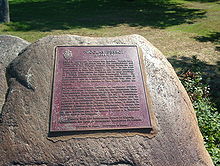Encyclopedia Dubuque
"Encyclopedia Dubuque is the online authority for all things Dubuque, written by the people who know the city best.”
Marshall Cohen—researcher and producer, CNN
Affiliated with the Local History Network of the State Historical Society of Iowa, and the Iowa Museum Association.
PERROT, Nicholas: Difference between revisions
No edit summary |
No edit summary |
||
| Line 24: | Line 24: | ||
''Dubuque Folklore'', American Trust and Savings Bank, 1976 | ''Dubuque Folklore'', American Trust and Savings Bank, 1976 | ||
Wilke, William. ''Dubuque on the Mississippi 1788-1988''. Dubuque, Iowa: Union Hoermann Press, 1987. | |||
Wikipedia | Wikipedia | ||
Revision as of 16:49, 23 May 2012
PERROT, Nicholas. (France, 1644-Canada, Aug. 13, 1717). Explorer, diplomat, fur trader, one of the first white men in the upper Mississippi Valley. Perrot came to New France around 1660 with Jesuits and had the opportunity to visit Indian tribes and learn their languages. He formed a fur trading company around 1667 and began expeditions to various tribes in and around present-day Wisconsin. He was sometimes the first white man seen by the native peoples and was generally well received.
In 1670 he was an interpreter for Daumont de Saint-Lusson, a French commissary assigned to the country of the Ottawas, Amikwas, Illinois, and other Indian natives to be discovered in the direction of Lake Superior. He continued to travel around these areas and engaged in fur trading giving the natives such items as cooking kettles and hatchets. He was given a land grant on the river Saint-Michel in present-day Quebec.
In 1684 Perrot succeeded in bringing the warriors of several nations to Niagara to meet with the Governor's army, where a peace treaty was signed. In the spring of 1685 he was appointed Commandant-in-Chief of Bais Des Puants (present day Green Bay, Wisconsin) and the neighboring regions when war broke out between the FOX, SIOUX, and Chippewa tribes. He worked hard to bring about peace and was successful for a time. After this, Perrot traveled to the northern waters of the Mississippi River, in the territory of the Sioux, where he built Fort Saint-Antoine.
In the spring of 1687 he was in the region of Detroit taking part in an expedition. A fire broke out at the Jesuit mission at Bais De Puants, and most his furs were destroyed. Perrot was financially ruined. He returned to Montreal where in the spring of 1688 he served as an interpreter for the treaty between Governor and Onondaga chief Otreouti, who promised the neutrality of the Onondagas, Cayugas, and Oneidas. In 1689 he built Fort Saint-Pierre at the mouth of the Wisconsin River and established peace among area tribes. In 1690, he and Louis de la Porte de Louvigny led a vital supply convoy from Montreal to Michilimackinac. Their success in breaking the Iroquois blockade of the Ottawa River and in resupplying the western Indians loyal to the French may have saved New France from the Five Nations.
According to what little is known, a group of MIAMI visited Perrot in 1690 and urged him to build a fort near present-day Wisconsin so that they could more easily trade with him. The chief presented the Frenchman with a rich piece of lead ore found along what is now believed to be CATFISH CREEK.
Perrot kept his word to build a trading site below the present-day Wisconsin River. This location is now believed to have been located on or near the bluffs of East Dubuque, Illinois across from the location of the lead mines. In 1700 French explorers found Perrot's settlement, well located to prevent surprise attack, and lead mines operating on the western shore of the Mississippi near what is now Dubuque.
In 1695 Perrot brought the Miami, SAUK, Menominee, Potawatomi and Fox chiefs to Montreal at the governor’s request, regarding war with the Iroquois. Perrot returned west where his concern was to maintain unity and peace among them in their efforts against the Iroquois. On two occasions he was almost sent to be burned at the stake with the Mascouten and the Miami tribe.
Perrot then settled on his land grant at Bécancour. The Indian chiefs whom he had known saw him for the last time in 1701 at the Great Peace of Montreal. He still served as interpreter, but this period of his life was marked by financial difficulties and harassment from creditors. He asked the authorities for a compensation he said was due to him, and a pension in consideration of services long provided, but was not satisfied. He was involved in court cases involving lawsuits filed by and against him. He also wrote his memoirs which became valuable to later historians.
Nicolas Perrot died on the 13th of August 1717 at about the age of 74 and was buried the next day in the church at Bécancour. Nine of his eleven children outlived him. His wife died in 1724.
Perrot was often underappreciated even during his lifetime, yet was France's best representative among Indians in the western territories of French North America. He was able to learn languages and customs of native tribes and earned their esteem and confidence. Perrot’s original journals were lost, although they were used extensively by early Canadian historians. Charles La Potherie received the journals from Perrot at the peace treaty of 1701 between France, England, and the Iroquois. La Potherie used the journals to write his history of New France, which was first published in four volumes in Paris in 1716, under the title Histoire de l’Amerique Septentrionale. The popularity of the volumes led to subsequent editions in 1722 and 1753.
---
Source:
Dubuque Folklore, American Trust and Savings Bank, 1976
Wilke, William. Dubuque on the Mississippi 1788-1988. Dubuque, Iowa: Union Hoermann Press, 1987.
Wikipedia


